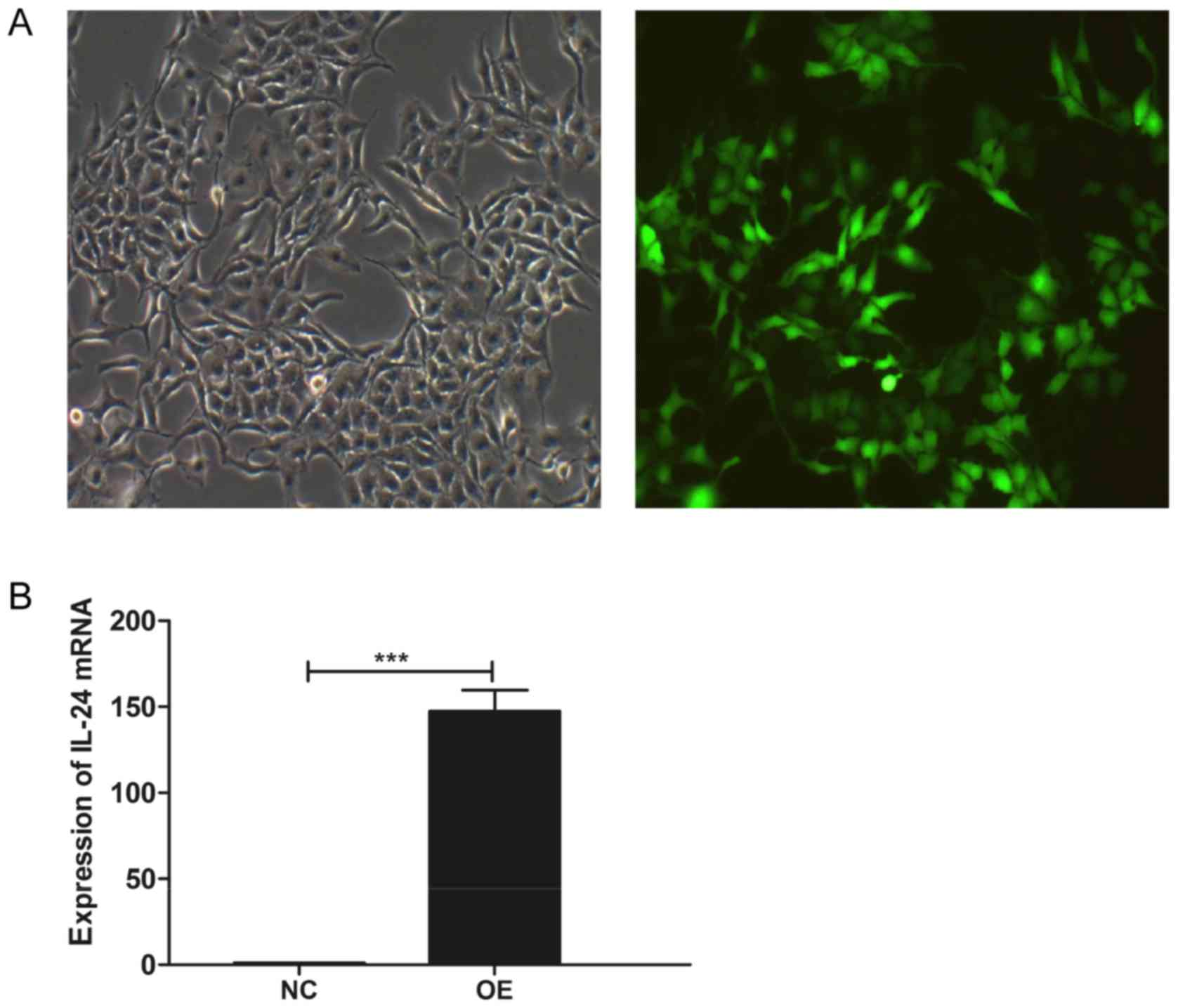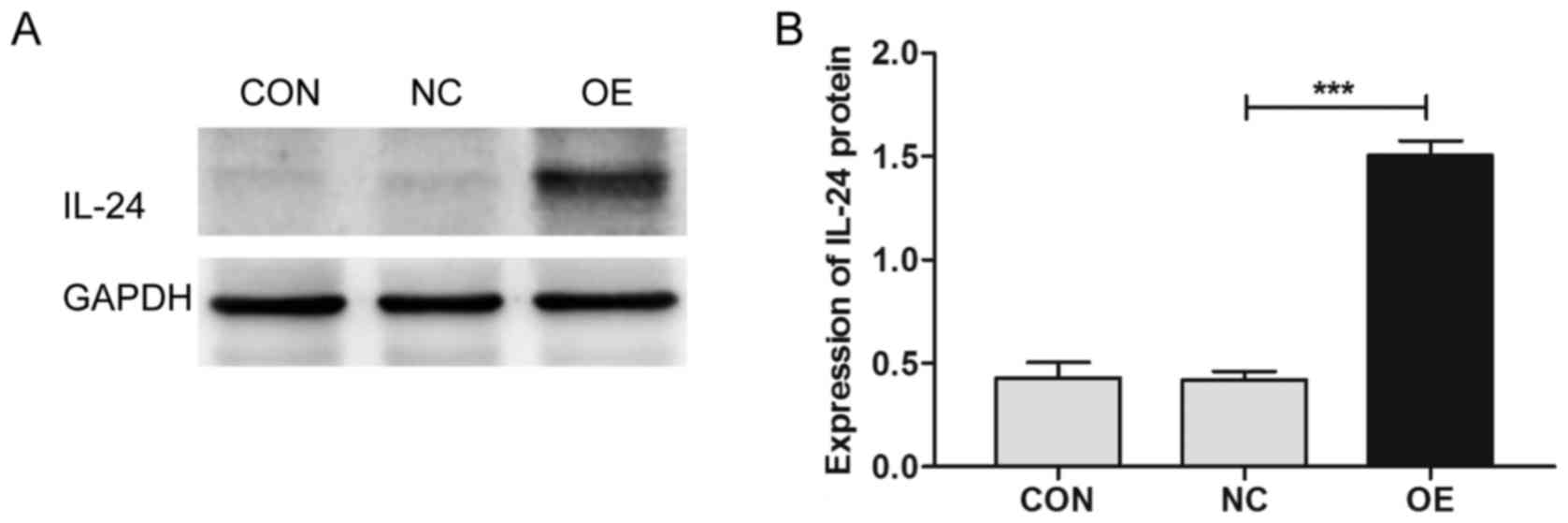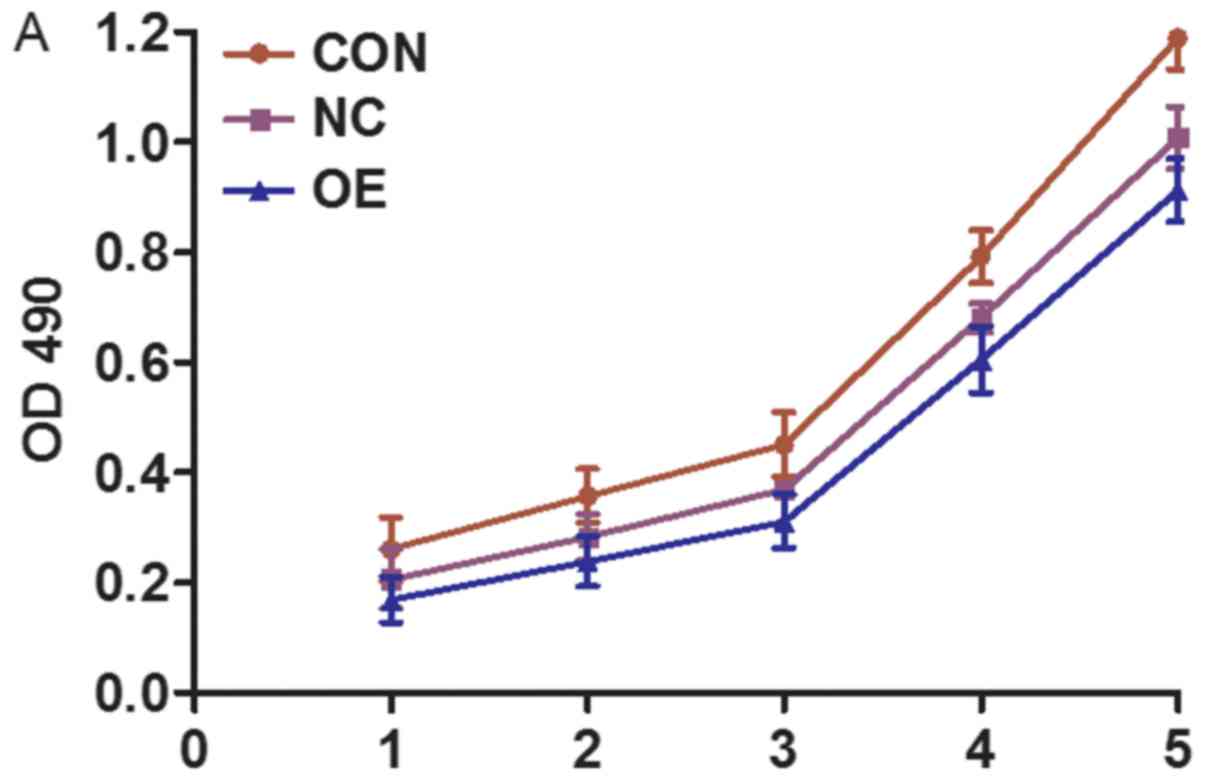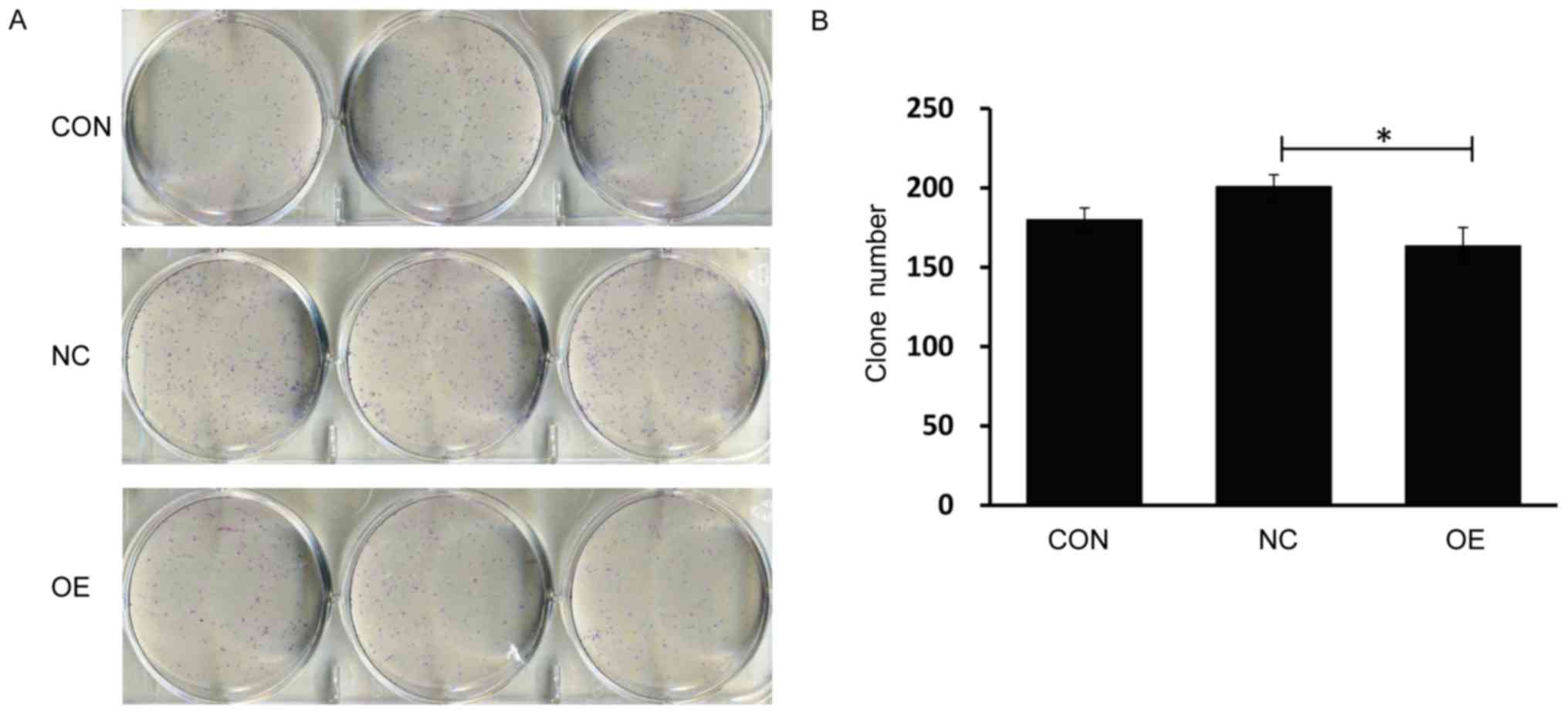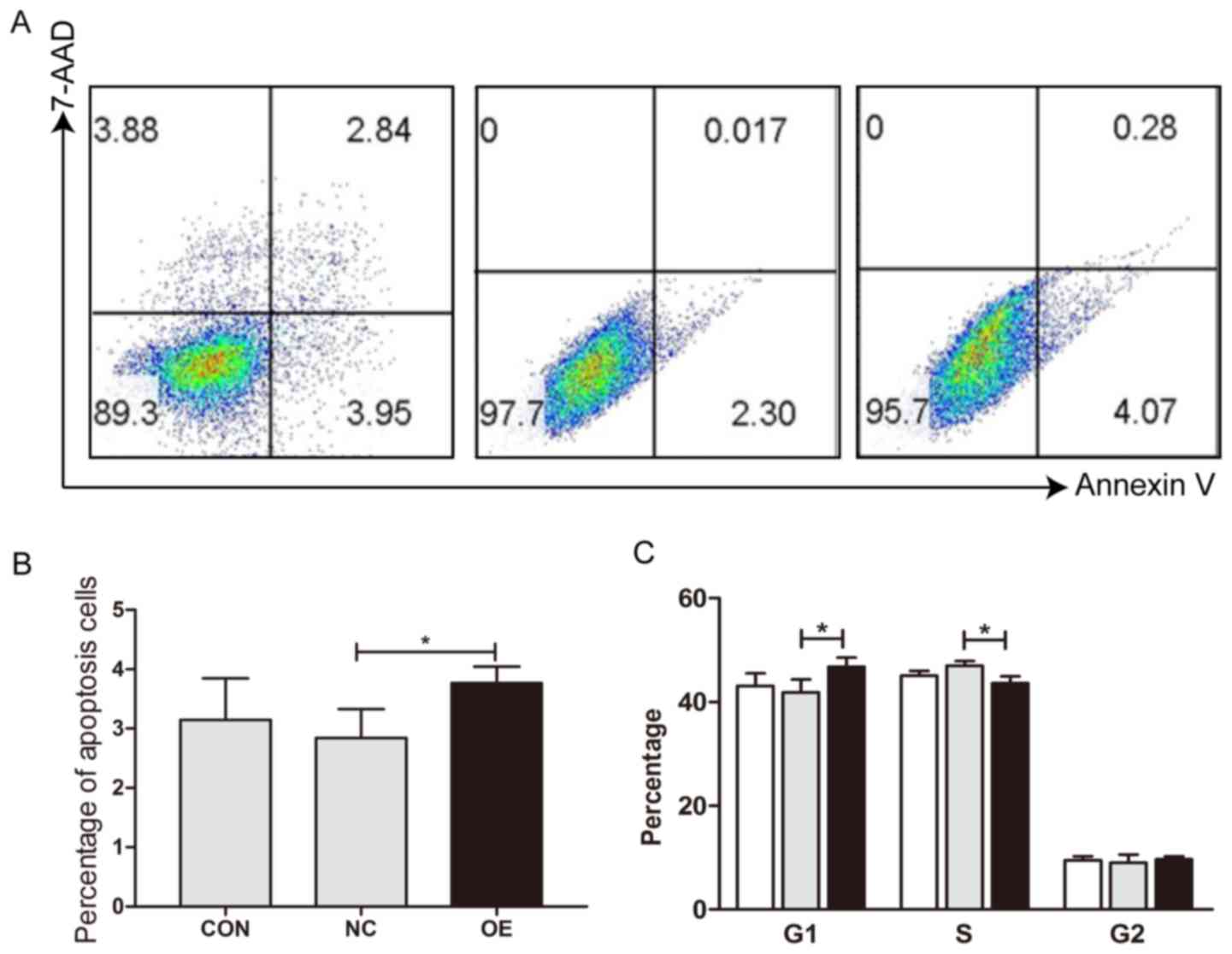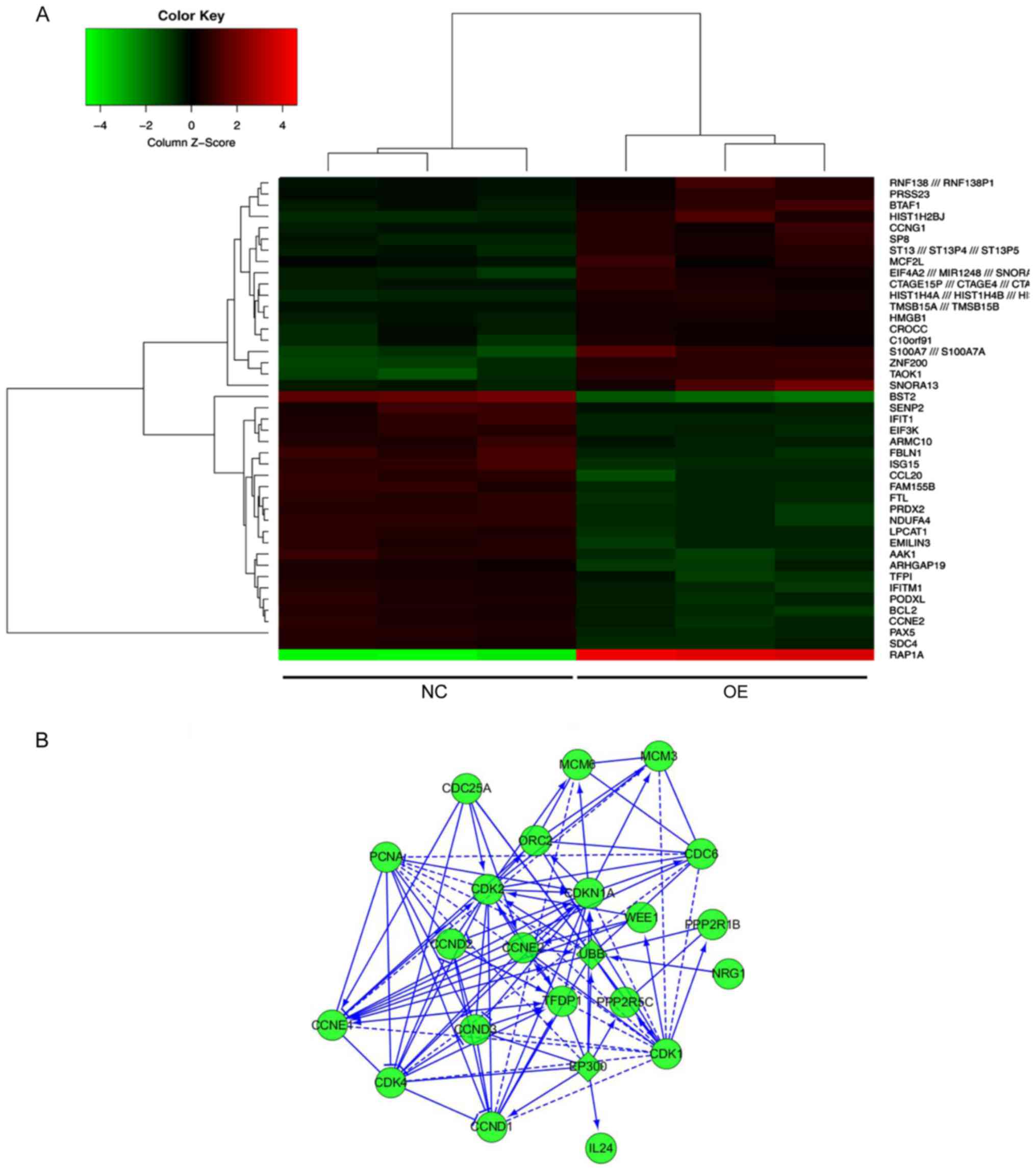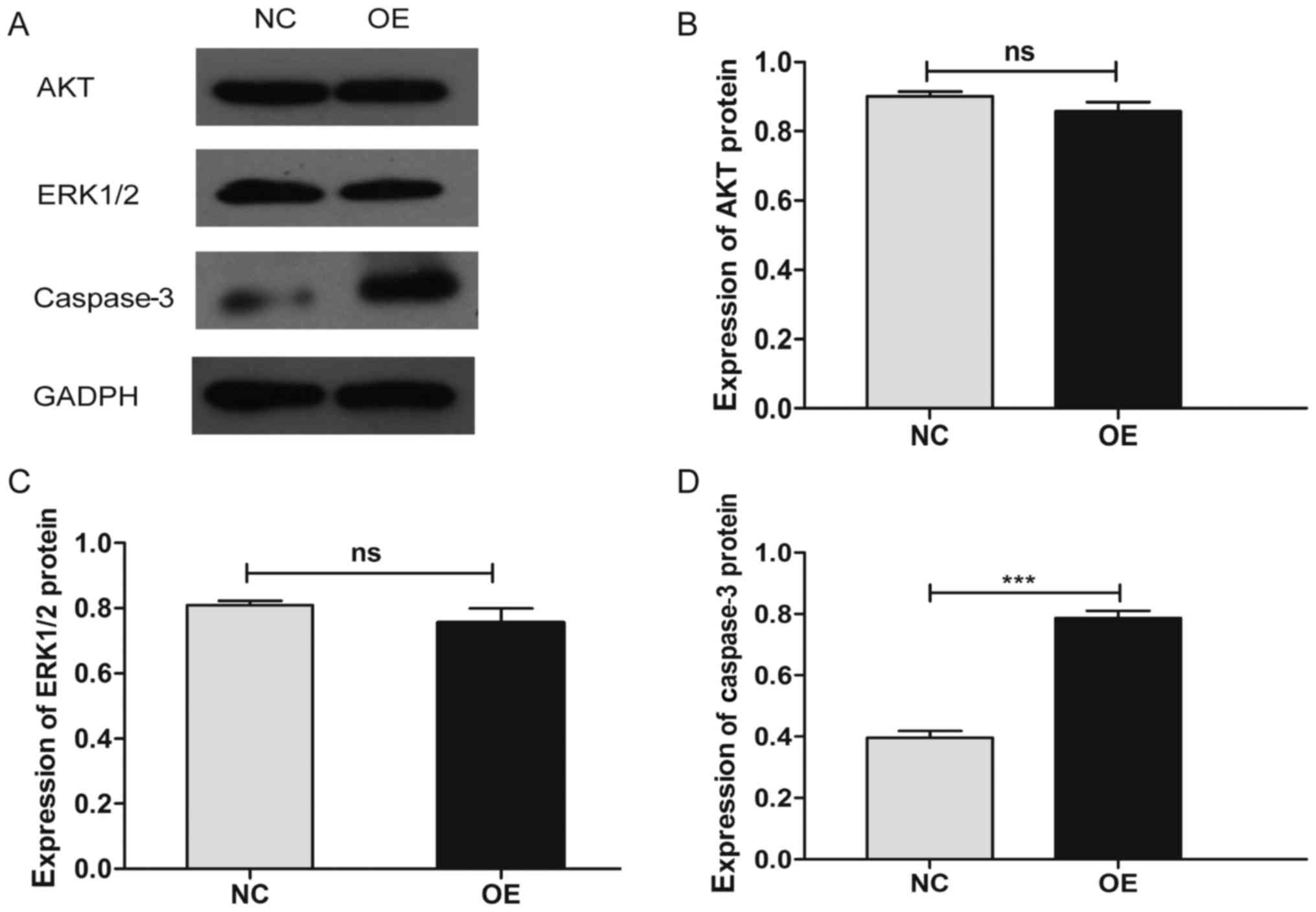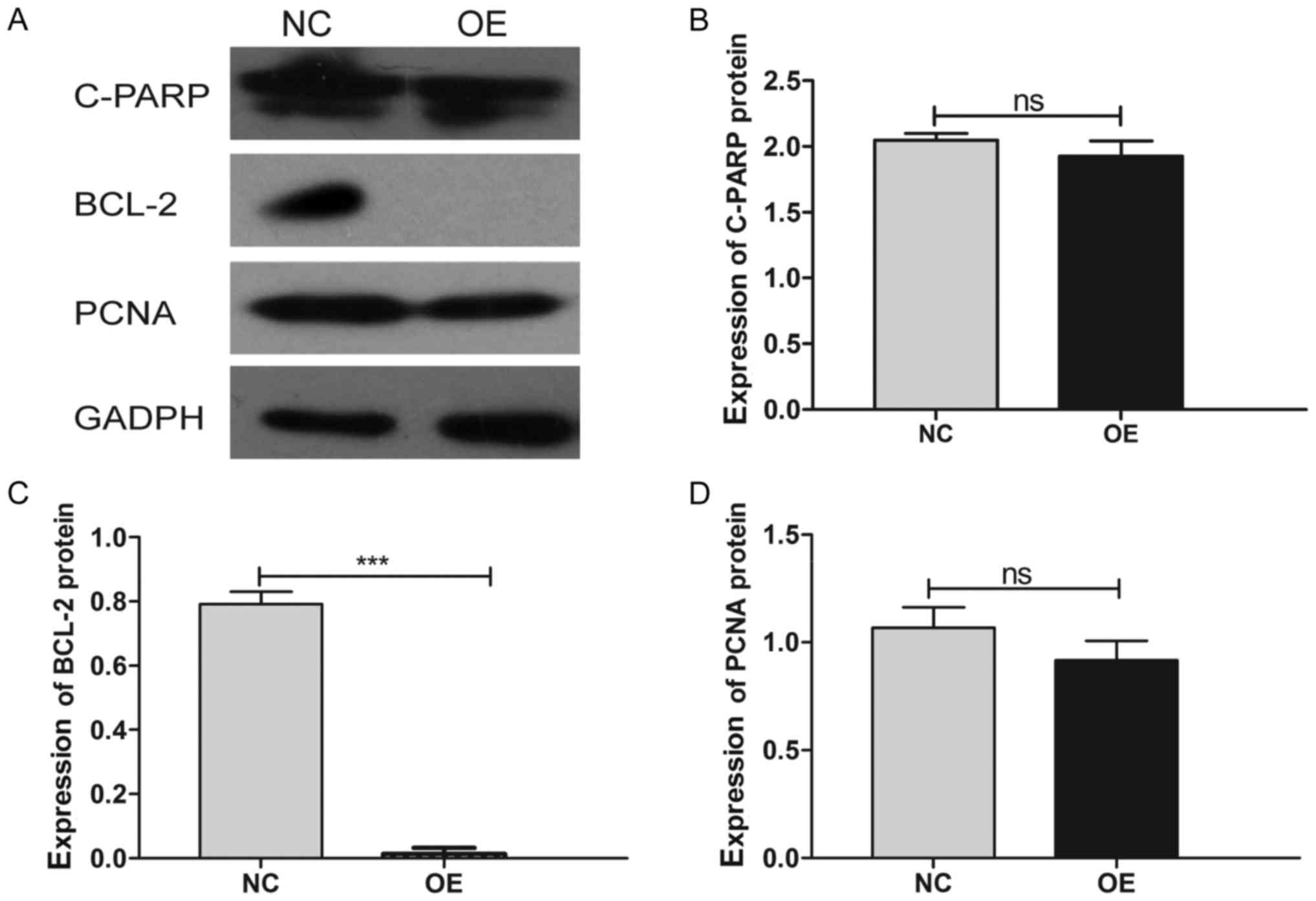Lentivirus‑mediated MDA7/IL24 expression inhibits the proliferation of hepatocellular carcinoma cells
- Authors:
- Published online on: February 16, 2018 https://doi.org/10.3892/mmr.2018.8616
- Pages: 5764-5773
-
Copyright: © Ma et al. This is an open access article distributed under the terms of Creative Commons Attribution License.
Abstract
Introduction
Hepatocellular carcinoma (HCC) is the most common malignancy of the liver and the third leading cause of cancer-related death worldwide. Despite the development of various therapies, the outcome for HCC patients remains poor. Generally, HCC patients have a 1-year survival rate of <50% and a 5-year survival rate of 10% (1). Annually, ~0.11 million people die from liver cancer in China, and the major reason for frequent HCC relapses are intrahepatic and distant metastases that develop after the curative surgical resection or transplantation (2). Moreover, HCC is insensitive to chemotherapy and radiotherapy (3). Therefore, novel HCC treatments such as gene therapy and molecular targeted therapy should be investigated (4). As a multitarget anticancer drug, sorafenib has been approved for the treatment of HCC, but showed a very low success rate (5). Gene therapy represents an alternative form of cancer treatment and was shown to have high efficiency, specificity, and few serious side effects (4).
Melanoma differentiation-associated gene7/interleukin-24 (MDA7/IL24), a member of the IL10 cytokine family, was originally identified as a gene associated with the terminal differentiation and irreversible growth suppression of metastatic human melanoma cells (6). MDA7/IL24 is considered to be secreted by the immune system and melanocytes alone (7,8). Several reports demonstrated the loss of MDA7/IL24 expression during the progression of melanoma, and a significant inverse correlation between the loss of this gene and tumor invasion, suggesting that MDA7/IL24 may have anticancer effects (6,7,9,10). Additionally, our previous studies demonstrated that MDA7/IL24 has multiple anticancer functions, selectively inducing cancer cell apoptosis, but also showing immunomodulatory and antiangiogenic properties and strong antitumor bystander effects, which makes this molecule an ideal candidate for cancer gene therapy (9–13).
We constructed MDA7/IL24-expressing lentiviral particles, and evaluated the effects of lentivirus-mediated MDA7/IL24 expression on HCC cell proliferation and colony-forming ability. Moreover, we explored the mechanisms underlying MDA7/IL24-mediated HCC regression (14).
Materials and methods
Cell lines and culture conditions
HCC cell line SMMC-7721 was obtained from Cell Bank of Chinese Academy of Sciences (Shanghai, China), and maintained in Dulbecco's modified Eagle's medium (DMEM) supplemented with 10% fetal bovine serum (FBS) and 100 U/ml of penicillin-streptomycin. The cells were incubated at 37°C in a humidified atmosphere with 5% CO2. In addition, the cell line is not contaminated or mis-identified according to the Database of Cross-Contaminated or Misidentified Cell Lines.
Recombinant lentiviral particle construction and infection
We constructed MDA7/IL24 gene expression plasmid, while an empty plasmid was used as a negative control. Following this, MDA7/IL24-expressing plasmid or the negative control plasmid, together with pHelper 1.0 and pHelper 2.0 (pVSVG-I and pCMVΔR 8.92 plasmids, respectively), were added to 293T cells with Lipofectamine 2000 (Invitrogen, Shanghai, China), according to the manufacturer's instructions. After 48 h of transfection, supernatants containing viral particles were collected and centrifuged (1,006 g, 20 min) to get rid of cell debris, and filtered through 0.45-µm polyvinylidene fluoride (PVDF) membranes. HCC cells were infected with MDA7/IL24-expressing lentiviral particles or the controls at the multiplicity of infection (MOI) of 20. The infected cells expressing green fluorescent protein (GFP) were observed under a fluorescence microscope (Micro Publisher 3.3RTV; Olympus, Tokyo, Japan). The cells were collected and total RNA was extracted to determine the efficiency of knockdown.
Reverse transcription-quantitative polymerase chain reaction (RT-qPCR)
Total RNA was extracted and purified from SMMC-7721-infected cells, using Trizol reagent (Invitrogen) following the manufacturer's instructions. RT was performed to generate cDNA molecules, using M-MLV reverse transcriptase (Promega, Madison, WI, USA) and oligo(dT) primers (Sangon, Shanghai, China), following the manufacturers' instructions. The expression of MDA7/IL24 was determined by quantitative real-time (qRT-) PCR, using a PCR assay kit (TransGen Biotech, Beijing, China). Glyceraldehyde-3-phosphate dehydrogenase (GAPDH) cDNA was amplified as an internal reference. MDA7/IL24 primer set: Forward, 5′-TTGCCTGGGTTTTACCCTGC-3′ and reverse, 5′-AAGGCTTCCCACAGTTTCTGG-3′; GAPDH forward, 5′-TGACTTCAACAGCGACACCCA-3′ and reverse, 5′-CACCCTGTTGCTGTAGCCAAA-3′. PCR conditions included initial denaturation (95°C for 10 sec) and then 40 cycles of amplification (95°C for 15 sec and 55°C for 15 sec). MDA7/IL24 relative expression was normalized to GAPDH levels by the 2−ΔΔCt method (15).
MTT assay
To investigate the effects of MDA7/IL24 overexpression on cell viability, MTT assay was performed three times. SMMC-772 cells in the logarithmic growth phase were cultured for 24 h in 96-well plates (1×105 cells per well). After the infection, cells were incubated for additional 72 h. Mitochondrial function was evaluated by MTT colorimetric assay. Briefly, the medium was removed and a fresh medium containing 0.5 mg/ml MTT was added to each well. The cells were incubated at 37°C for 4 h. Following this, the supernatants were removed, 50 µl dimethylsulfoxide (DMSO) was added to each well, and samples were incubated for 30 min at 37°C with gentle shaking. Finally, absorbance was determined using a microplate reader at 490 nm. Cell viability was calculated as the ratio of the absorbance determined in the samples infected with the MDA7/IL24 overexpression plasmid to that of the control group (untreated cells).
Colony formation assay
Infected and untreated SMMC-7721 cells were plated in six-well plates (200 cells/well) and cultured in a 5% CO2 incubator at 37°C for 14 days. The cells were washed twice with PBS and fixed in 4% paraformaldehyde for 30 min. Cell colonies were stained with Giemsa dye (Chemicon, Temecula, CA, USA) for 20 min, and washed with double distilled water several times. Colony numbers were counted under a fluorescence microscope.
Cell cycle
Cells were cultured in 12-cell plates. After 5 days, the cells were collected and fixed with cold 70% ethanol overnight at −20°C, and then washed with cold PBS for one time. The fixed cells were treated with RNase and stained with propidium iodide (Sigma, St. Louis, MO, USA). The stained cells were analyzed by flow cytometer and ModFit LT software (Verity Software House, Topsham, ME, USA).
Cell apoptosis
Cell apoptosis was performed using Annexin V PE and 7-AAD apoptosis detection kit (BD Bioscience, San Diego, CA, USA) according to the manufacturer's instructions. Cells were collected after cultured 5 days, washed and resuspended with 1xbinding buffer. Then 5 µl Annexin V was added into 200 µl of the above cell suspension and incubated at room temperature in the dark for 15 min. After incubation, 5 µl 7-AAD was added the cell apoptosis was detected using the flow cytometer.
Microarray processing and analysis
Total RNA isolated from SMMC-7721 cells infected with either lentiviral vector expressing (LV-)MDA7/IL24 (n=3) or negative control lentivirus (n=3) was subjected to microarray analysis, to determine the global transcriptomic profile of each cell group, using Affymetrix human GeneChip according to the manufacturer's instructions. Microarray hybridization, washing, and staining were performed using the GeneChip Hybridization Wash and Stain kit (Affymetrix, Santa Clara, CA, USA). Arrays were then scanned using the GeneChip Scanner 3,000 to obtain raw data (Affymetrix). Significant differences in the expression of the analyzed genes between SMMC-7721 cells infected with either LV-MDA7/IL24 or negative control lentivirus were obtained based on P<0.05.
Western blot analysis
Seventy-two h after the infection of SMMC-7721 cells with either LV-MDA7/IL24 or negative control lentivirus, the cells were collected and washed with PBS twice, and the lysis buffer was added to extract the cellular proteins. Afterwards, the lysates were centrifuged at 14,000 rpm at 4°C for 10 min and the supernatants were collected. BCA method was applied to determine the protein concentration. Twenty micrograms of protein sample obtained from the infected cells was separated by 10% SDS-PAGE and then transferred to PVDF membrane. PVDF membranes were blocked at 4°C overnight with 5% bovine serum albumin and incubated with monoclonal antibodies against B cell lymphoma protein-2 (BCL2; 1:500; ab692; Abcam, Cambridge, UK), Cyclin E (1:1,000; cat. no. 4132), p-ERK1/2 (1:800; cat. no. 4370), p-AKT (1:2,000; cat. no. 4060) and caspase-3 (1:1,000; cat. no. 9662; all CST Biological Reagents Co., Ltd., Shanghai, China). Thereafter, the horseradish peroxidase-conjugated secondary antibody we added for each corresponding primary antibody. The obtained blots were analyzed using enhanced chemiluminescence. GAPDH was detected on the same membrane as a loading control.
Statistical analysis
Student's t-test was performed for data analysis. Statistical analysis was performed using the SPSS version 22.0 software (SPSS, Chicago, IL, USA). All data were presented as mean ± standard deviation (SD) of the results obtained in three independent experiments. P<0.05 was considered to indicate a statistically significant difference.
Results
LV-MDA7/IL24 infection induces MDA7/IL24 overexpression in SMMC-7721 cells
As presented in Fig. 1A, SMMC-7721 cells were shown to be GFP-positive following the infection with the lentiviral particles, indicating a high efficiency of the infection. Further analysis demonstrated a significant upregulation of MDA7/IL24 expression in these cells (P<0.001), compared with that in the cells infected with the negative control lentiviruses (Figs. 1B and 2).
MDA7/IL24 overexpression inhibits SMMC-7721 cell proliferation and colony-forming ability
LV-MDA7/IL24-infected SMMC-7721 cells were shown to have a decreased growth rate, in comparison with the untreated and negative control-treated cells (P<0.05). At day 5, we determined that the optical density at 490 nm (OD490) of LV-MDA7/IL24-infected cells was 0.921±0.013, while those of the negative control-infected and untreated cells were 0.988±0.007 and 1.094±0.007, respectively (Fig. 3). Colony-forming ability of SMMC-7721 cells was analyzed by crystal violet staining, and the number of cells per colony significantly decreased after LV-MDA7/IL24 infection (P<0.05). Furthermore, we determined the number of colonies, and this number was found to decrease to 163±12 in samples overexpressing MDA7/IL24, compared with those in the untreated and negative control-treated cells (180±8 and 201±8, respectively) (Fig. 4).
MDA7/IL24 overexpression induces cell arrest and apoptosis
To demonstrate the reasons why MDA7/IL24 overexpression results in reduced cell viability, apoptosis and cell cycle of MDA7/IL24 positive and negative HCC cells were examined by flow cytometry. The results showed that MDA7/IL24 overexpression induced cell apoptosis (Fig. 5A and B) and elevated the percentage of G1 phage cells in SMMC-7721 cells (Fig. 5C).
MDA7/IL24 overexpression affects multiple cancer development pathways
To explore the molecular mechanisms underlying the anticancer effects of MDA7/IL24, we performed microarray analysis and gene expression profiling in cells infected with either LV-MDA7/IL24 or the negative control. A significant difference in the expression levels between these cells was observed for 43 genes, 20 with upregulated and 23 with downregulated expression (Fig. 6A). KEGG pathway analysis demonstrated that these genes were significantly enriched in three pathways, including cell cycle regulation, DNA synthesis and transcriptional and apoptosis (Fig. 6B). Additionally, we verified the differential expression of several key molecules involved in these two pathways by western blotting, which showed that the upregulation of MDA7/IL24 induces the expression of caspase-3 and downregulates the expression of p-AKT, p-ERK1/2, CCNE2, and BCL2 (Figs. 7–10).
Discussion
Gene therapy has become a focus of current investigations aimed at improving HCC treatment (16). MDA7/IL24 is a member of the IL10 cytokine family, and was shown to induce apoptosis in different cancers specifically, including HCC (17), lung cancer (18), melanoma (19), breast cancer (20), pancreatic cancer (21), cervical cancer (22), and prostate cancer (23), but it does not affect normal cells (24). Therefore, this gene may represent an ideal gene therapy target (25). Additionally, MDA7/IL24 can induce the activation of immune system response aimed against cancer cells, and effectively inhibit neoplastic angiogenesis. It was demonstrated that the overexpression of this molecule and chemotherapy have synergistic effects (26). However, MDA7/IL24 overexpression mediated by lentiviruses has not been investigated previously.
Here, we constructed a LV-MDA7/IL24, and confirmed that the expression levels of this gene increase in SMMC-7721 cells infected with lentiviral particles carrying this vector. This demonstrated that the recombinant lentiviruses effectively promote the expression of MDA7/IL24 in HCC cells. MTT and colony formation assays demonstrated that lentivirus-mediated MDA7/IL24 expression markedly inhibits HCC cell proliferation. The number of cells and cell growth rate of LV-MDA7/IL24-infected cells were shown to be significantly decreased. In accordance with the results obtained in a previous study (27), we demonstrated the anticancer effects of MDA7/IL24.
However, the molecular mechanisms underlying the effects of MDA7/IL24 on HCC cells remain unclear. We performed gene expression profiling of SMMC-7721 cells infected with LV-MDA7/IL24, demonstrating that many genes show significantly different expression between MDA7/IL24-overexpressing cells and the control cells. We further performed functional pathway analysis, and several pathways involving the differentially expressed genes were found to be involved in cancer development (14), for example, G1/S checkpoint and G2/M DNA damage signaling pathway. These pathways are crucial for cell cycle regulation, DNA synthesis, and transcription. Previously, it was reported that MDA7/IL24 induces IL20/IL22 receptor-independent apoptosis by modulating multiple apoptotic signaling pathways such as mitochondrial pathway, MAPK, PKR, GADD pathways, and others (28–30), and is involved in the accumulation of BAX and BCL2 (31). The results of our western blot analysis showed that MDA7/IL24 induces the expression of caspase-3 and inhibits the expression of p-AKT, p-ERK1/2, CCNE2, and BCL2.
CCNE2 and p-ERK1/2 are molecules involved in cell cycle regulation, which can induce tumor progression by regulating cell cycle transition. Cyclin E2 is a member of cyclin E family, which forms cyclin E-CDK2 complex with CDK2 (6). This complex promotes cell cycle progression by regulating G1/S phase transition, and the dysregulation of cyclin E2-CDK2 activity was shown to be involved in tumor development (32). Moreover, the overexpression of cyclin E2 was shown to be associated with poor survival of breast cancer patients (33). P-ERK1/2 is the activated form of ERK1/2, which plays an important role in cell proliferation by regulating cell cycle progression (34). P-ERK1/2 was demonstrated to be a HCC prognostic marker, since increased p-ERK1/2 levels correlate with a decrease in the overall survival (35). MDA7/IL24 overexpression induces CCNE2 and p-ERK1/2 downregulation, indicating that this molecule suppresses tumor progression by regulating cell cycle transition. Just as demonstrated by the experimental results, IL-24 overexpression induced G1 arrest in human HCC cells.
BCL2 is a 26-kDa oncoprotein, and its carcinogenic property is closely associated with the anti-apoptotic activity (36). As a regulator of apoptosis, BCL2 may promote tumor cell survival and inhibit apoptosis through the regulation of mitochondrial membrane permeability and the induction of tumor angiogenesis (37). BCL2 overexpression is related to tumor progression (38). P-AKT, an active form of AKT, plays an important role in the inhibition of tumor cell apoptosis, promoting tumor cell proliferation and angiogenesis (39). Many studies demonstrated that p-AKT is highly activated in many tumors, and its abnormal expression was shown to be closely related to tumor development and progression (40). Members of caspase family are key elements in the process of apoptosis, and their activation and abnormal expression can induce apoptosis through the interaction with other factors (41). Caspase-3 is the most important member of the caspase family involved in the process of apoptosis, mediating signaling triggered by many other molecules (42). In the present study, the expression levels of p-AKT, BCL2, and caspase-3 were shown to differ between the cells overexpressing MDA7/IL24 and the controls, indicating that MDA7/IL24 can inhibit tumor progression by inducing apoptosis, which is consistent with the results of cell functional experiments.
Taken together, our results demonstrate that MDA7/IL24 can inhibit the proliferation and suppress tumorigenicity of HCC cells in vitro. Furthermore, the MDA7/IL24 exerts its effects through the regulation of cell cycle transition and the induction of apoptosis. Therefore, we demonstrated that MDA7/IL24 has anticancer functions, its overexpression inhibits HCC progression, and it may represent a novel therapeutic target for cancer treatment.
Acknowledgements
The present study was supported by the National Natural Science Foundation of China Youth Fund (81201673). The manuscript was edited and proofread by Editage.
References
|
Wang CJ, Xiao CW, You TG, Zheng YX, Gao W, Zhou ZQ, Chen J, Xue XB, Fan J and Zhang H: Interferon-α enhances antitumor activities of oncolytic adenovirus-mediated IL-24 expression in hepatocellular carcinoma. Mol Cancer. 11:312012. View Article : Google Scholar : PubMed/NCBI | |
|
Han B, Liu SH, Guo WD, Zhang B, Wang JP, Cao YK and Liu J: Notch1 downregulation combined with interleukin-24 inhibits invasion and migration of hepatocellular carcinoma cells. World J Gastroenterol. 21:9727–9735. 2015. View Article : Google Scholar : PubMed/NCBI | |
|
El-Serag HB, Marrero JA, Rudolph L and Reddy KR: Diagnosis and treatment of hepatocellular carcinoma. Gastroenterology. 134:1752–1763. 2008. View Article : Google Scholar : PubMed/NCBI | |
|
Li J, Shi L, Zhang X, Kang X, Wen Y, Qian H, Zhou Y, Xu W, Zhang Y, Wu M and Yin Z: Recombinant adenovirus IL-24-Bax promotes apoptosis of hepatocellular carcinoma cells in vitro and in vivo. Cancer Gene Ther. 17:771–779. 2010. View Article : Google Scholar : PubMed/NCBI | |
|
Xiao CW, Xue XB, Zhang H, Gao W, Yu Y, Chen K, Zheng JW and Wang CJ: Oncolytic adenovirus-mediated MDA-7/IL-24 overexpression enhances antitumor activity in hepatocellular carcinoma cell lines. Hepatobiliary Pancreat Dis Int. 9:615–621. 2010.PubMed/NCBI | |
|
Huo W, Li ZM, Zhu XM, Bao YM and An LJ: MDA-7/IL-24 suppresses tumor adhesion and invasive potential in hepatocellular carcinoma cell lines. Oncol Rep. 30:986–992. 2013. View Article : Google Scholar : PubMed/NCBI | |
|
Jiang H, Lin JJ, Su ZZ, Goldstein NI and Fisher PB: Subtraction hybridization identifies a novel melanoma differentiation associated gene, mda-7, modulated during human melanoma differentiation, growth and progression. Oncogene. 11:2477–2486. 1995.PubMed/NCBI | |
|
Huang EY, Madireddi MT, Gopalkrishnan RV, Leszczyniecka M, Su Z, Lebedeva IV, Kang D, Jiang H, Lin JJ, Alexandre D, et al: Genomic structure, chromosomal localization and expression profile of a novel melanoma differentiation associated (mda-7) gene with cancer specific growth suppression and apoptosis inducing properties. Oncogene. 20:7051–7063. 2001. View Article : Google Scholar : PubMed/NCBI | |
|
Ellerhorst JA, Prieto VG, Ekmekcioglu S, Broemeling L, Yekell S, Chada S and Grimm EA: Loss of MDA7 expression with progression of melanoma. J Clin Oncol. 20:1069–1074. 2002. View Article : Google Scholar : PubMed/NCBI | |
|
Sarkar D, Su ZZ, Vozhilla N, Park ES, Gupta P and Fisher PB: Dual cancer specific targeting strategy cures primary and distant breast carcinomas in nude mice. Proc Natl Acad Sci USA. 102:pp. 14034–14039. 2005; View Article : Google Scholar : PubMed/NCBI | |
|
Caudell EG, Mumm JB, Poindexter N, Ekmekcioglu S, Mhashilkar AM, Yang XH, Retter MW, Hill P, Chada S and Grimm EA: The protein product of the tumor suppressor gene, melanoma differentiation-associated gene 7, exhibits immunostimulatory activity and is designated IL-24. J Immunol. 168:6041–6046. 2002. View Article : Google Scholar : PubMed/NCBI | |
|
Fisher PB, Gopalkrishnan RV, Chada S, Ramesh R, Grimm EA, Rosenfeld MR, Curiel DT and Dent P: mda7/IL-24, a novel cancer selective apoptosis inducing cytokine gene: From the laboratory into the clinic. Cancer Biol Ther. 2 4 Suppl 1:S23–S37. 2003. View Article : Google Scholar : PubMed/NCBI | |
|
Tong AW, Nemunaitis J, Su D, Zhang Y, Cunningham C, Senzer N, Netto G, Rich D, Mhashilkar A, Parker K, et al: Intratumoral injection of INGN 241, a nonreolicating adenovector expressing the melanoma-differentiation associated gene-7 (mda7/IL-24): Biologic outcome in advanced cancer patients. Mol Ther. 11:160–172. 2005. View Article : Google Scholar : PubMed/NCBI | |
|
Lebedeva IV, Sauane M, Gopalkrishnan RV, Sarkar D, Su ZZ, Gupta P, Nemunaitis J, Cunningham C, Yacoub A, Dent P and Fisher PB: Mda7/IL-24: Exploiting cancer's Achilles' heel. Mol Ther. 11:4–18. 2005. View Article : Google Scholar : PubMed/NCBI | |
|
Song Z, Lin J, Sun Z, Ni J and Sha Y: RNAi-mediated downregulation of CDKL1 inhibits growth and colony-formation ability, promotesapoptosis of human melanoma cells. J Dermatol Sci. 79:57–63. 2015. View Article : Google Scholar : PubMed/NCBI | |
|
Diao J, Wu C, Zhang J, Liu J, Zhang X, Hao P, Zhao S and Zhang Z: Loss of diacylglycerol kinase-Ζ inhibits cell proliferation and survival in human gliomas. Mol Neurobiol. 53:5425–5435. 2016. View Article : Google Scholar : PubMed/NCBI | |
|
Xue XB, Xiao CW, Zhang H, Lu AG, Gao W, Zhou ZQ, Guo XL, Zhong MA, Yang Y and Wang CJ: Oncolytic adenovirus SG600-IL24 selectively kills hepatocellular carcinoma cell lines. World J Gastroenterol. 16:4677–4684. 2010. View Article : Google Scholar : PubMed/NCBI | |
|
Wang X, Ye Z, Zhong J, Xiang J and Yang J: Adenovirus-mediated Il-24 expression suppresses hepatocellular carcinoma growth via induction of cell apoptosis and cycling arrest and reduction of angiogenesis. Cancer Biother Radiopharm. 22:56–63. 2007. View Article : Google Scholar : PubMed/NCBI | |
|
Emdad L, Lebedeva IV, Su ZZ, Gupta P, Sarkar D, Settleman J and Fisher PB: Combinatorial treatment of non-small cell lung cancers with gefitinib and Ad.mda-7 enhances apoptosis-induction and reverses resistance to a single therapy. J Cell Physiol. 210:549–559. 2007. View Article : Google Scholar : PubMed/NCBI | |
|
Sarkar D, Su ZZ, Lebedeva IV, Sauane M, Gopalkrishnan RV, Valerie K, Dent P and Fisher PB: mda-7 (IL-24) mediates selective apoptosis in human melanoma cells by inducing the coordinated overexpression of the GADD family of genes by means of p38 MAPK. Proc Natl Acad Sci USA. 99:pp. 10054–10059. 2002; View Article : Google Scholar : PubMed/NCBI | |
|
McKenzie T, Liu Y, Fanale M, Swisher SG, Chada S and Hunt KK: Combination therapy of Ad-mda7 and trastuzumab increases cell death in Her-2/neu-overexpressing breast cancer cells. Surgery. 136:437–442. 2004. View Article : Google Scholar : PubMed/NCBI | |
|
Lebedeva IV, Su ZZ, Sarkar D, Gopalkrishnan RV, Waxman S, Yacoub A, Dent P and Fisher PB: Induction of reactive oxygen species renders mutant and wild-type K-ras pancreatic carcinoma cells susceptible to Ad.mda-7-induced apoptosis. Oncogene. 24:585–596. 2005. View Article : Google Scholar : PubMed/NCBI | |
|
Shi H, Wei LL, Yuan CF, Yang JX, Yi FP, Ma YP and Song FZ: Melanoma differentiation-associated gene-7/interleukin 24 inhibits invasion and migration of human cervical cancer cells in vitro. Saudi Med J. 11:1671–1675. 2007. | |
|
Menezes ME, Shen XN, Das SK, Emdad L, Guo C, Yuan F, Li YJ, Archer MC, Zacksenhaus E, Windle JJ, et al: MDA-7/IL-24 functions as a tumor suppressor gene in vivo in transgenic mouse models of breast cancer. Oncotarget. 6:36928–36942. 2015. View Article : Google Scholar : PubMed/NCBI | |
|
Saito Y, Miyahara R, Gopalan B, Litvak A, Inoue S, Shanker M, Branch CD, Mhashilkar AM, Roth JA, Chada S and Ramesh R: Selective induction of cell cycle arrest and apoptosis in human prostate cancer cells through adenoviral transfer of the melanoma differentiation associated-7 (mda-7)/interleukin-24 (IL-24) gene. Cancer Gene Ther. 12:238–247. 2005. View Article : Google Scholar : PubMed/NCBI | |
|
Kawabe S, Nishikawa T, Munshi A, Roth JA, Chada S and Meyn RE: Adenovirus-mediated mda-7 gene expression radiosensitizes non-small cell lung cancer cells via TP53-independent mechanisms. Mol Ther. 6:637–644. 2002. View Article : Google Scholar : PubMed/NCBI | |
|
Sauane M, Gopalkrishnan RV, Sarkar D, Su ZZ, Lebedeva IV, Dent P, Pestka S and Fisher PB: MDA-7/IL-24: Novel cancer growth suppressing and apoptosis inducing cytokine. Cytokine Growth Factor Rev. 14:35–51. 2003. View Article : Google Scholar : PubMed/NCBI | |
|
Sauane M, Gopalkrishnan RV, Lebedeva I, Mei MX, Sarkar D, Su ZZ, Kang DC, Dent P, Pestka S and Fisher PB: Mda-7/IL-24 induces apoptosis of diverse cancer cell lines through JAK/STAT-independent pathways. J Cell Physiol. 196:334–345. 2003. View Article : Google Scholar : PubMed/NCBI | |
|
Su ZZ, Lebedeva IV, Sarkar D, Gopalkrishnan RV, Sauane M, Sigmon C, Yacoub A, Valerie K, Dent P and Fisher PB: Melanoma differentiation associated gene-7, mda-7/IL-24, selectively induces growth suppression, apoptosis and radiosensitization in malignant gliomas in a p53-independent manner. Oncogene. 22:1164–1180. 2003. View Article : Google Scholar : PubMed/NCBI | |
|
Su ZZ, Lebedeva IV, Sarkar D, Emdad L, Gupta P, Kitada S, Dent P, Reed JC and Fisher PB: Ionizing radiation enhances therapeutic activity of mda-7/IL-24: Overcoming radiation- and mda-7/IL-24-resistance in prostate cancer cells overexpressing the antiapoptotic proteins bcl-xL or bcl-2. Oncogene. 25:2339–2348. 2006. View Article : Google Scholar : PubMed/NCBI | |
|
Tahara I, Miyake K, Hanawa H, Kurai T, Hirai Y, Ishizaki M, Uchida E, Tajiri T and Shimada T: Systemic cancer gene therapy using adeno-associated virus type 1 vector expressing MDA-7/IL24. Mol Ther. 15:1805–1811. 2007. View Article : Google Scholar : PubMed/NCBI | |
|
Zhao Z, Liu J, Wang C, Wang Y, Jiang Y and Guo M: MicroRNA-25 regulates small cell lung cancer cell development and cell cycle through cyclin E2. Int J Clin Exp Pathol. 7:7726–7734. 2014.PubMed/NCBI | |
|
Ye L, Guo L, He Z, Wang X, Lin C, Zhang X, Wu S, Bao Y, Yang Q, Song L and Lin H: Upregulation of E2F8 promotes cell proliferation and tumorigenicity in breast cancer by modulating G1/S phase transition. Oncotarget. 17:23767–23771. 2016. | |
|
Hwang HC and Clurman BE: Cyclin E in normal and neoplastic cell cycles. Oncogene. 24:2776–2786. 2005. View Article : Google Scholar : PubMed/NCBI | |
|
Zhao S, Qiu ZX, Zhang L and Li WM: Prognostic values of ERK1/2 and p-ERK1/2 expressions for poor survival in non-small cell lung cancer. Tumor Biol. 36:4143–4150. 2015. View Article : Google Scholar | |
|
Li Q and Yang Z: Expression of phospho-ERK1/2 and PI3-K in benign and malignant gallbladder lesions and its clinical and pathological correlations. J Exp Clin Cancer Res. 28:652009. View Article : Google Scholar : PubMed/NCBI | |
|
Sabokrouh A, Vaisi-Raygani A, Goodarzi MT, Khatami S, Taghizadeh-Jahed M, Shahabadi N, Lakpour N and Shakiba Y: Comparison between platinum-azidothymidine and azidothymidine effects on Bcl-2 and telomerase gene expression in rats with hepatocellular carcinoma. Avicenna J Med Biotech. 7:50–56. 2015. | |
|
Zhao N, Sun BC, Zhao XL, Wang Y, Meng J, Che N, Dong XY and Gu Q: Role of Bcl-2 and its associated miRNAs in vasculogenic mimicry of hepatocellular carcinoma. Int J Clin Exp Pathol. 8:15759–15768. 2015.PubMed/NCBI | |
|
Correia C, Lee SH, Meng XW, Vincelette ND, Knorr KL, Ding H, Nowakowski GS, Dai H and Kaufmann SH: Emerging understanding of Bcl-2 biology: Implications for neoplastic progression and treatment. Biochim Biophys Acta. 1853:1658–1671. 2015. View Article : Google Scholar : PubMed/NCBI | |
|
Xu LF, Ni JY, Sun HL, Chen YT and Wu YD: Effects of hypoxia-inducible factor-1α silencing on the proliferation of CBRH-7919 hepatoma cells. World J Gastroenterol. 19:1749–1759. 2013. View Article : Google Scholar : PubMed/NCBI | |
|
Mackenzie RW and Elliott BT: Akt/PKB activation and insulin signaling: A novel insulin signaling pathway in the treatment of type 2 diabetes. Diabetes Metab Syndr Obes. 7:55–64. 2014. View Article : Google Scholar : PubMed/NCBI | |
|
Cui R, Kim T, Fassan M, Meng W, Sun HL, Jeon YJ, Vicentini C, Tili E, Peng Y, Scarpa A, et al: MicroRNA-224 is implicated in lung cancer pathogenesis through targeting caspase-3 and caspase-7. Oncotarget. 6:21802–21815. 2015. View Article : Google Scholar : PubMed/NCBI |



